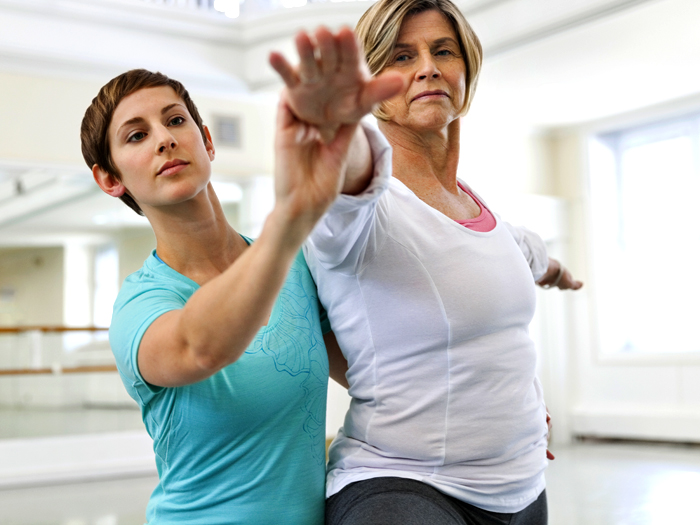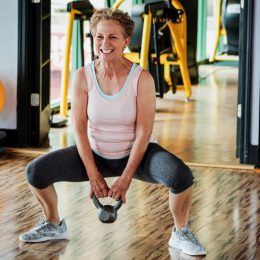5 Tweaks That Will Make Your Workout Much More Effective
Adopt these incredibly simple upgrades to get better results starting today.

Finding a workout you enjoy can involve some trial and error, but it’s also the key to exercising consistently. So if you’ve done that, congratulations! The hardest part is behind you.
Your new focus: continuing to get results from that same routine. And luckily, it’s easier than you think. Whether you prefer group fitness classes or solo strength sessions at the gym, there are ways to ensure you get the most from every second you sweat.
Adopt these five simple but powerful upgrades to avoid plateaus and maximize your results.
Workout Upgrade #1: Move Through Your Full Range of Motion
Can you go a little deeper into warrior two pose or lower your chest closer to the floor during pushups? If so, go for it!
Exercising through your body’s full range of motion forces your muscles to work harder and adapt faster, according to a 2017 study in the Journal of Strength and Conditioning Research.
Plus, prior research shows using your full range of motion during weight training—meaning you don’t cut any movements short—can improve your flexibility as well as stretching does.
To determine your healthy range of motion for any given exercise, try performing several reps with little to no resistance. Pay attention to how far each joint can comfortably bend while allowing you to maintain proper form. As soon as your form starts to break down, you’ve gone too far.
Watch yourself in a mirror, take a video on your phone, or ask a trainer at your local gym or community center to observe your body positioning. And keep in mind the more you exercise, the more range of motion you’ll have available over time.
Workout Upgrade #2: Exhale During the Hardest Part of an Exercise
Your body doesn’t do anything, let alone get in a good workout, without oxygen. Yet many people tend to hold their breath when exercising or working hard.
“Holding your breath can reduce your power, strength, and endurance while also increasing your risk of dizziness and headaches,” says Lou Centeno, C.P.T, owner of Fit Results in Chicago.
On the flip side, proper breathing technique can help you get more out of your moves, he says. During every exercise, you have eccentric and concentric phases. Put simply, the eccentric phase is the easy half of the exercise, when you’re relaxing the muscle by lowering your body with gravity or releasing tension in a resistance band. The concentric phase is the hard part, when you’re exerting yourself during a lift, push, or pull.
“Inhale through the eccentric, easier phase and forcefully exhale during the concentric phase,” Centeno says. Doing so will help you brace your core to increase total-body strength and function when you need it most.
Let’s say you’re doing a biceps curl. Inhale in starting position with your arms down. Exhale as you curl up (concentric). Inhale as you release back to starting position (eccentric).
Workout Upgrade #3: Slow Down
When it comes to strength training, speed doesn’t equal quality. Slow, controlled movements tend to be more beneficial than quick ones.
The reason: Moving slowly during strength exercises increases the amount of time your muscles are under tension, Centeno says. This makes each move more challenging and therefore more effective at improving muscle health, he says.
What’s more, when you slow down, you can’t use momentum or cheat with improper form. This boosts your results—and reduces your risk of injury. It’s a win-win.
For resistance exercises, focus on performing the concentric phase (the lift, push, or pull) for one second and the eccentric phase (the lowering or release) more slowly over the count of two to three seconds. Pause briefly at the top and bottom of each movement, making sure not to bounce or use momentum.
You can apply this concept to your whole workout with this slow-and-steady strength circuit.
Workout Upgrade #4: Fuel Your Body
While this may not be something you do during your workout, it’s just as important for maximizing your results.
“Getting in proper fuel—which includes both food and fluids—is critical to exercise performance and making sure that you can give each workout your all,” says Mark Barroso, C.P.T., a New Jersey-based personal trainer.
Subscribe to our newsletter
It's quick and easy. You could be one of the 13 million people who are eligible.
Already a member? Click to discover our 15,000+ participating locations.
Follow Us
If you have a chronic condition like diabetes or heart disease, talk to your doctor about any personalized dietary recommendations.
If you don’t have doctor-recommended guidelines, try eating something that includes both low-glycemic carbohydrates and lean protein one hour prior to exercise. Low-glycemic carbs include most fruits and vegetables, beans, minimally processed grains, pasta, low-fat dairy foods, and nuts. Their job is to keep your blood sugar level steady and make sure you’re fueled throughout your workout. Lean proteins will digest before your workout, making sure your muscles have what they need for exercise.
Examples of great pre-workout snacks include:
- Apple + low-fat string cheese
- 100-calorie granola bar + ½ cup berries
- 2 brown rice cakes each topped with 1 tablespoon hummus + cucumber slices
Meanwhile, even slight dehydration can torpedo your energy levels, muscle function, and safety. For adequate hydration, the American College of Sports Medicine generally recommends drinking:
- 16 to 20 ounces of water four hours before exercise
- When you’re thirsty during exercise
- 16 to 24 ounces of fluid for every pound lost during exercise
That’s right, you can actually lose pounds of water weight during a workout. Hop on the scale before and after your session to help determine your ideal fluid needs. And be sure you’re aware of these sneaky signs of dehydration.
Workout Upgrade #5: Constantly Challenge Yourself
It’s always a good idea to talk to your doctor before trying any new exercise routine—especially high-intensity ones—but don’t be afraid to push yourself in small ways. Whatever your current fitness level, improving it depends on progressively increasing your activity levels.
If you perform the same workout day in and day out without increasing its difficulty, your body will stop adapting, Barroso says. To increase difficulty safely, try adjusting just one of these factors:
- Exercise frequency, such as adding one more SilverSneakers class per week
- Duration, such as doing a few more minutes or one more set of exercise
- Weight, such as choosing a slightly heavier dumbbell or band
- Speed, such as picking up your pace from moderate to brisk walk
- Range of motion, such as progressing from wall pushups to bench pushups
To make sure you continue progressing, pay attention to how hard you feel like you’re working during each workout. When an exercise becomes easy, it means two things: First, you’re getting stronger, and second, it’s time to step it up!
Check Your SilverSneakers Eligibility Instantly
SilverSneakers gives you free, unlimited access to more than 15,000 gyms and fitness centers across the nation, plus classes and tools designed to keep older adults strong and independent. Check your eligibility instantly here.





